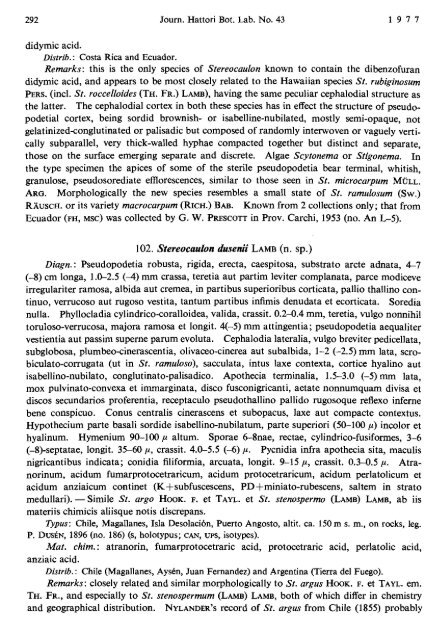A CONSPECTUS OF THE LICHEN GENUS STEREOCAULON ...
A CONSPECTUS OF THE LICHEN GENUS STEREOCAULON ...
A CONSPECTUS OF THE LICHEN GENUS STEREOCAULON ...
You also want an ePaper? Increase the reach of your titles
YUMPU automatically turns print PDFs into web optimized ePapers that Google loves.
Journ. Hattori Bot. Lab. No. 43<br />
didymic acid.<br />
Distrib. : Costa Rica and Ecuador.<br />
Remarks: this is the only species of Stereocaulon known to contain the dibenzofuran<br />
didymic acid, and appears to be most closely related to the Hawaiian species St. rubiginosum<br />
PERS. (incl. St. roccelloides (TH. FR.) LAMB), having the same peculiar cephalodial structure as<br />
the latter. The cephalodial cortex in both these species has in effect the structure of pseudopodetial<br />
cortex, being sordid brownish- or isabelline-nubilated, mostly semi-opaque, not<br />
gelatinized-conglutinated or palisadic but composed of randomly interwoven or vaguely vertically<br />
subparallel, very thick-walled hyphae compacted together but distinct and separate,<br />
those on the surface emerging separate and discrete. Algae Scytonema or Stigonema. In<br />
the type specimen the apices of some of the sterile pseudopodetia bear terminal, whitish,<br />
granulose, pseudosorediate efflorescences, similar to those seen in St. microcarpum MULL.<br />
ARG. Morphologically the new species resembles a small state of St. ramulosum (Sw.)<br />
RAusc~. or its variety macrocarpurn (RICH.) BAB. Known from 2 collections only; that from<br />
Ecuador (FH, MSC) was collected by G. W. PRESCOTT in Prov. Carchi, 1953 (no. An L-5).<br />
102. Stereocaulon dusenii LAMB (n. sp.)<br />
Diagn.: Pseudopodetia robusta, rigida, erecta, caespitosa, substrato arcte adnata, 4-7<br />
(-8) cm longa, 1.0-2.5 (4) mm crassa, teretia aut partim leviter complanata, parce modiceve<br />
irregulariter ramosa, albida aut cremea, in partibus superioribus corticata, pallio thallino continuo,<br />
verrucoso aut rugoso vestita, tantum partibus infimis denudata et ecorticata. Soredia<br />
nulla. Phyllocladia cylindrico-coralloidea, valida, crassit. 0.2-0.4 mm, teretia, vulgo nonnihil<br />
toruloso-verrucosa, majora ramosa et longit. 4(-5) mm attingentia; pseudopodetia aequaliter<br />
vestientia aut passim superne parum evoluta. Cephalodia lateralia, vulgo breviter pedicellata,<br />
subglobosa, plumbeo-cinerascentia, olivaceo-cinerea aut subalbida, 1-2 (-2.5) mm lata, scrobiculato-corrugata<br />
(ut in St. ramuloso), sacculata, intus laxe contexta, cortice hyalino aut<br />
isabellino-nubilato, conglutinato-palisadico. Apothecia terminalia, 1.5-3.0 (-5) mm lata,<br />
mox pulvinato-convexa et immarginata, disco fusconigricanti, aetate nonnumquam divisa et<br />
discos secundarios proferentia, receptaculo pseudothallino pallido rugosoque reflex0 inferne<br />
bene conspicuo. Conus centralis cinerascens et subopacus, laxe aut compacte contextus.<br />
Hypothecium parte basali sordide isabellino-nubilatum, parte superiori (50-100 p) incolor et<br />
hyalinum. Hymenium 90-100 p altum. Sporae Clnae, rectae, cylindrico-fusiformes, 3-6<br />
(-8)-septatae, longit. 35-60 p, crassit. 4.0-5.5 (-6) p. Pycnidia infra apothecia sita, maculis<br />
nigricantibus indicata; conidia filiformia, arcuata, longit. 9-15 p, crassit. 0.3-0.5 p. Atranorinum,<br />
acidum fumarprotocetraricum, acidum protocetraricum, acidum perlatolicum et<br />
acidum anziaicum continet (K+subfuscescens, PDSminiato-rubescens, saltem in strato<br />
medullari). -Simile St. argo HOOK. F. et TAYL. et St. stenospermo (LAMB) LAMB, ab iis<br />
materiis chimicis aliisque notis discrepans.<br />
Typus: Chile, Magallanes, Isla Desolacibn, Puerto Angosto, altit. ca. 150 m s. m., on rocks, leg.<br />
P. DUSBN, 1896 (no. 186) (s, holotypus; CAN, UPS, isotypes).<br />
Mat. chim.: atranorin, fumarprotocetraric acid, protocetraric acid, perlatolic acid,<br />
anziaic acid.<br />
Distrib. : Chile (Magallanes, AysBn, Juan Fernandez) and Argentina (Tierra del Fuego).<br />
Remarks: closely related and similar morphologically to St. argus HOOK. F. et TAYL. em.<br />
TH. FR., and especially to St. stenospermum (LAMB) LAMB, both of which differ in chemistry<br />
and geographical distribution. NYLANDER'S record of St. argus from Chile (1855) probably

















